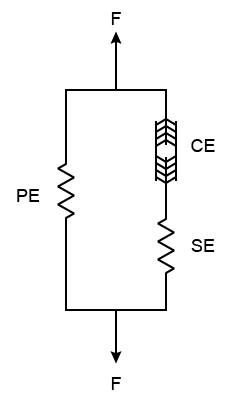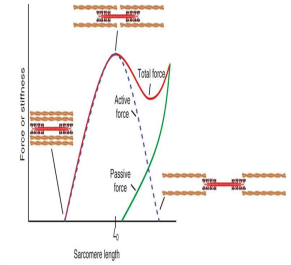Muscle Biomechanics
Original Editor - Mmadu-Okoli Chukwunonso Oluebube
Top Contributors - Blessed Denzel Vudzijena, Mmadu-Okoli Chukwunonso Oluebube and Rucha Gadgil
Introduction[edit | edit source]
Skeletal muscles are organized multinucleated myofibers, whose function is to generate length and velocity dependent forces for movement or stability. They are controlled by the nervous system, thus movement or stability is a mechanical event produced by skeletal muscles and controlled by a complex system of voluntary, spinal and sensory control[1]. Muscle function depends on their intrinsic properties and extrinsic arrangement. [2]
Components[edit | edit source]
The skeletal muscles could be organized in three different components based on their function and architecture namely[3]
- The Series Elastic Component (SEC)
- The Parallel Elastic Component (PEC)
- The Contractile Component.
The series and parallel elastic component are defined in parallel relation to their arrangement with the contractile components, the later arranged in line with the contractile components. The parallel elastic component is suggested to consist of the membranes surrounding the contractile components which includes the sarcolemma, sarcoplasmic retinaculum [4], the perimysium and the epimysium [5], while the series elastic components reside in the tendons and aponeuroses[4].
Length-tension relationship[edit | edit source]
Tension refers to the amount of force built up within a muscle[6]. The total tension is a combination of passive (non-contractile) & active (contractile units) tension. Generally, a muscle is capable of being shortened to approximately 1/2 of its normal resting length & stretched about 2 times its normal resting length. The distance between maximum elongation to maximum shortening is referred to as excursion, and usually a muscle has sufficient excursion to allow the joint to move through the joint’s entire range. The action responsible for the contraction of a muscle occurs within a sarcomere and force generation is dependent on the amount of overlap between thin and thick myofilaments [1]. The greater the number of cross bridges attached to the actin filaments, the larger the contraction force [2]. The length-tension curve below summarizes the relationship between muscle length and tension during force production. It is important to note that two joint muscles undergo active and passive insufficiency during simultaneous movements.
Factors affecting force production[edit | edit source]
- Fiber Type
- % Fiber Recruitment
- Fiber Architecture
- Number of Muscle Fibers
- Angle of Pull
- Muscle Temperature
- Rate of Stimulation
- Force-velocity Relationship
- Elastic Properties
Functions[edit | edit source]
In addition to irritability, contractility, extensibility, extensibility, elasticity is one of the properties of a muscle, necessary for optimal function[7]. These non-contractile components contribute to the passive force generated by the muscles. It is thought that the PEC distributes forces during passive stretching and maintains the alignment of muscle fibers while the SEC serves to store up elastic energy to be released during muscle contraction [5] and play a role in stability during isometric contraction[4]
Clinical Implication[edit | edit source]
The ability to stretch muscles (Muscle Compliance) could be explained from the neurological (when considering the neurophysiological basics of muscle tone) and biomechanical models of the skeletal muscle. Intramuscular connective tissue framework (non-contractile components) serves to distribute forces during muscle stretching [8]. Studies have suggested that optimal muscle function is probably achieved by increasing muscle length, length extensibility, passive elastic stiffness, mass and strength[9] [10] It has also been shown that an increase in the collagen to muscle fibre tissue exist as well as reconfiguration of collagen arrangements in immobilized muscles [8] suggesting the roles of the biomechanical model in clinical management of muscle stiffness and contractures hence consideration should be put into the rehabilitation and clinical management of such conditions.
During plyometric exercises, the SEC is known to store up potential energy that is released during the concentric muscle contraction serving as a spring[11] suggesting the role these components play in shock absorption especially during walking. The perception of Delay Onset Muscle Soreness (DOMS) after eccentric contraction is caused by microtrauma to the PEC and the SEC, (Minor SD 1987 as cited by Davies G)[11].
Conclusion[edit | edit source]
Much focus to the contractile components of the muscles is given in clinical practice, and backed up by neurophysiological models explaining force generation, in consideration of neuronal drive. Bearing in mind these other components and the role of fiber lengths and cross sectional areas in optimal muscle function is also necessary for clinicians. These provide better theoretical understanding of the concepts of passive stretching, plyometric exercises, etc. in the management of patients.
References[edit | edit source]
- ↑ Herzog W, The Biomechanics of Muscle Contraction or Firing Biomechanics Research, 4th Kuala Lumpur International Conference on Biomedical Engineering 2008: Kuala Lumpur, Malaysia. Berlin: Springer, 2008
- ↑ Schneck DJ, Bronzino JD. Biomechanics Principles and Applications. Florida, CRC Press 2002
- ↑ Bahler AS. Series elastic component of mammalian skeletal muscle. American Journal of Physiology-Legacy Content. 1967 Dec 1;213(6):1560-4.
- ↑ 4.0 4.1 4.2 Rode C, Siebert T, Herzog W, Blickhan R. The effects of parallel and series elastic components on the active cat soleus force-length relationship. Journal of Mechanics in Medicine and Biology. 2009 Mar;9(01):105-22.
- ↑ 5.0 5.1 Staurt BP. Tidy’s Physiotherapy. Saunders Elsevier 2013
- ↑ Hazari A, Maiya A, Nagda T. Conceptual Biomechanics and Kinesiology: Applied Biomechanics on Joint, Muscle, Tendon, and Ligament. Singapore: Springer, 2021.
- ↑ Binder-Markey B, Sychowski D, Lieber R. Systematic review of skeletal muscle passive mechanics experimental methodology. Journal of Biomechanics. 2021; 129.
- ↑ 8.0 8.1 Williams PE, Goldspink G. Connective tissue changes in immobilised muscle. Journal of Anatomy. 1984 Mar;138(Pt 2):343.
- ↑ Gajdosik RL. Passive extensibility of skeletal muscle: review of the literature with clinical implications. Clinical Biomechanics. 2001; 16(suppl 2): 87-101.
- ↑ Blazevich A. Adaptations in the passive mechanical properties of skeletal muscle to altered patterns of use. Journal of applied physiology. 2019; 126: 1483-1491
- ↑ 11.0 11.1 Davies G, Riemann BL, Manske R. Current concepts of plyometric exercise. International journal of sports physical therapy. 2015 Nov;10(6):760.








